NVIDIA’s Transformative Impact on the PC Gaming Market
Ryan Shrout
Introduction
NVIDIA has consistently been at the forefront of PC gaming innovation, driving leaps in graphics technology and user experience over the decades. From inventing the modern GPU in 1999 to pioneering real-time ray tracing in consumer games, NVIDIA’s contributions have reshaped what gamers can expect from their hardware and software. In recent years, the company has doubled down on integrating AI into gaming, introducing technologies like DLSS (Deep Learning Super Sampling), Reflex, RTX Remix, ACE, G-Assist, and Broadcast, each changing and improving the gaming experience in unique ways. These advancements address the growing demands for higher fidelity, better performance, lower latency, and even more immersive interactions in games.
My goal with this editorial is to provide some historical context and modern highlights of NVIDIA’s impact on PC gaming, illustrating why many consider NVIDIA the most important and innovative company in this space. We’ll explore each major technology, why its need was driven by hardware limits and gamer expectations, and how it has been adopted across the industry. Data on performance improvements, such as those from DLSS and frame generation, and adoption metrics will underscore the scale of NVIDIA’s influence. In doing so, we’ll see how NVIDIA’s unique approach, a tight integration of cutting-edge hardware and proprietary software, has delivered milestones no one else had achieved at the time, ultimately benefiting the PC gaming ecosystem despite criticism over open-source practices.
Over the past few decades NVIDIA has shaped nearly every major leap in PC gaming, from inventing the first GPU that unlocked true 3D complexity to introducing AI‑driven features like DLSS, Reflex, and RTX that redefine performance, realism, and responsiveness. Its ecosystem of hardware and software has turned once‑impractical ideas, real‑time ray tracing, advanced physics, AI upscaling, into everyday expectations, while tools like RTX Remix, Broadcast, and ACE show how NVIDIA extends innovation beyond graphics into modding, streaming, and in‑game intelligence. Though sometimes criticized for proprietary approaches, the company’s relentless R&D has consistently pushed the industry forward, giving gamers and developers new capabilities and cementing NVIDIA as a driving force in the evolution of PC gaming.
Modern AI-Powered Technologies
Enhancing Gaming
Deep Learning Super Sampling (DLSS) and Frame Generation
One of NVIDIA’s most significant recent innovations is Deep Learning Super Sampling (DLSS). First introduced in 2018 alongside RTX GPUs, DLSS uses neural networks to render games more efficiently. Instead of rendering every frame at full resolution, the game is rendered at a lower resolution and then upscaled to the desired output using an AI model, often improving image quality with learned details. Early versions of DLSS (1.0) showed promise but were sometimes criticized for artifacts. NVIDIA iterated quickly, and DLSS 2.0 in 2020 became a game‑changer with a generalized AI model and temporal feedback that produced sharp, stable images often indistinguishable from native rendering. This delivered large performance boosts, with 4K games running at much higher frame rates with minimal loss in visual fidelity.
By late 2022, DLSS 3 arrived, adding Frame Generation for GeForce 40‑series GPUs. Frame Generation produces new intermediate frames using AI, increasing the frame rate beyond what the game engine can normally output. This further improved the perception of performance in compatible games.
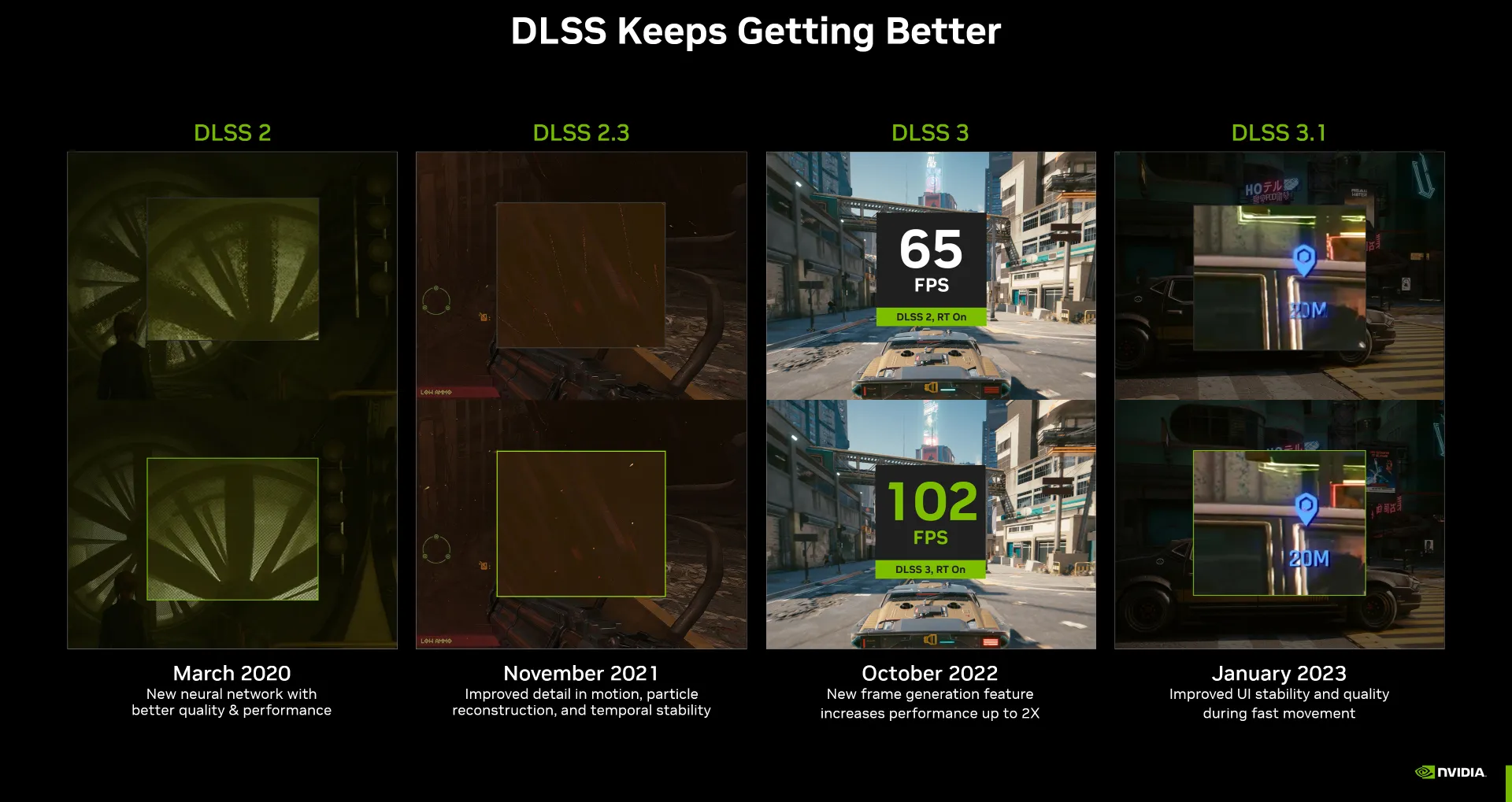
The impact can be significant. Games that would otherwise be unplayable at high resolutions with ray tracing can run smoothly. NVIDIA highlights that DLSS enables “industry‑leading AI graphics acceleration, capable of delivering up to 5 times faster performance in the most immersive games.” For example, enabling DLSS and Frame Generation in a demanding title like Cyberpunk 2077 or Alan Wake 2 can raise frame rates from around 30 FPS to well over 100 FPS on the same GPU. Microsoft Flight Simulator, long limited by CPU, saw a 106% FPS increase when DLSS 3’s Frame Generation was applied compared to DLSS 2. In the Unity Enemies tech demo, DLSS 3 boosted average FPS by 235% versus native rendering. These are gains difficult to achieve through hardware upgrades alone.
Performance benefits vary by game. DLSS Quality mode often provides 40–60% improvements at 4K, with diminishing returns at lower resolutions. Frame Generation’s multiplier effect depends on the title and base frame rate, and some games show artifacts or input lag. In many scenarios, though, DLSS excels.
NVIDIA addresses latency concerns with Reflex, which is tightly coupled with DLSS 3. When Frame Generation is on, Reflex is enabled to keep latency low. In the Unity demo, native 4K had about 35 ms of latency, while DLSS 3 at a much higher FPS reduced latency to around 10 ms. When base frame rates are already high, generated frames can feel less responsive because they do not include new input data.
Early DLSS versions sometimes produced blurry text, ghosting, or flickering details, but later models have reduced these issues. By early 2023, nearly 400 games and apps supported RTX features like DLSS, and by August 2024 that number surpassed 600. Major engines like Unreal and Unity include DLSS integration, and gamers often expect new AAA releases to support it. DLSS continues to evolve, with DLSS 3.5 adding Ray Reconstruction to further improve ray‑traced image quality. NVIDIA’s head start in AI upscaling maintains its lead in this space.
NVIDIA Reflex: Combating Latency for Competitive Play
Even the most beautiful graphics and high frame rates mean little if a game feels laggy or unresponsive. Recognizing this, NVIDIA introduced NVIDIA Reflex in September 2020 to minimize input lag in games. Reflex combines an SDK for developers with GPU driver optimizations to ensure frames are rendered just in time. Without Reflex, the CPU can feed the GPU faster than it can display frames, causing a render queue that adds latency. Reflex aligns game engine work to finish just in time for rendering, eliminating the queue so you see your input reflected as quickly as possible.
The result is a snappier, more responsive feel, critical in competitive shooters, battle royales, and other twitch‑sensitive titles. With Reflex enabled (usually through a simple in‑game setting), system latency can drop significantly. In games like Fortnite or Valorant, Reflex can cut latency by 20 to 30 percent under GPU‑bound conditions. Even in single‑player games such as Star Wars: Outlaws, NVIDIA reported latency reductions of up to 31 percent. Importantly, Reflex does not reduce image quality or frame rate. It simply optimizes timing, making it a must‑have for gamers who want the most responsive experience.
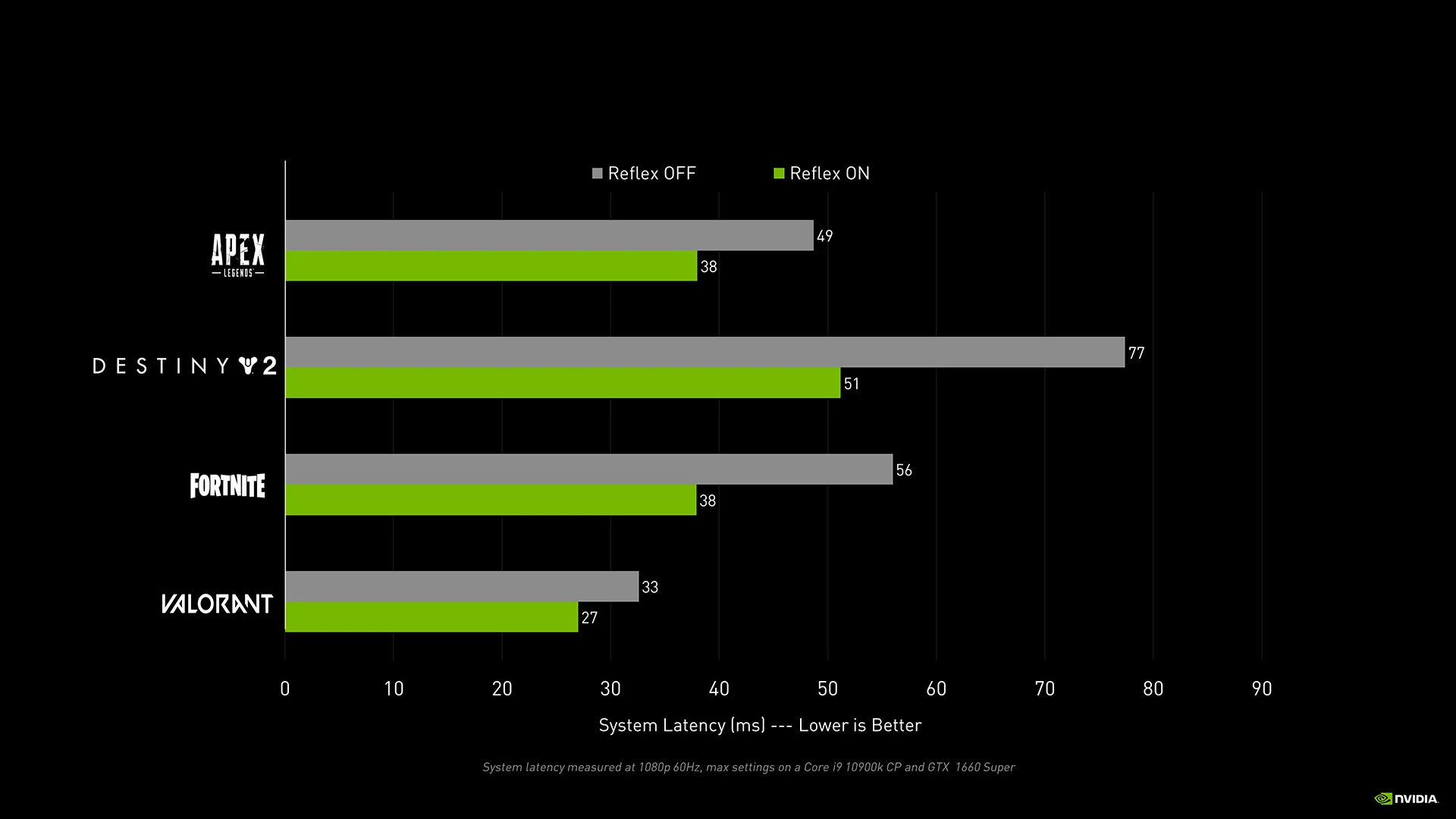
Adoption has been strong. Since 2020, over 100 games have added Reflex, including 9 of the top 10 competitive shooters on PC. Popular esports titles such as Counter‑Strike 2, Valorant, Fortnite, and Call of Duty support it, some with Reflex enabled by default. By 2023, over 90 percent of GeForce players had Reflex enabled in supported games, contributing to more than 10 billion hours of improved gameplay that year. NVIDIA reports about 50 million monthly users, showing this is not a niche feature.
Reflex also includes measurement tools. The Reflex Latency Analyzer, used with compatible monitors and mice, lets players track click‑to‑photon latency without specialized equipment. This makes it easier to fine‑tune a setup and eliminate hidden delays.
Reflex addresses an area raw GPU power cannot solve: latency. It shows NVIDIA’s focus on making games feel more connected and immediate. While its benefits are greatest in GPU‑bound situations and require developer support, its deep integration and broad adoption help define modern high‑end PC gaming.
RTX Remix: Remastering Classic Games with AI and Ray Tracing
One of NVIDIA’s more novel initiatives is RTX Remix, a modding platform designed to breathe new life into classic PC games. Announced in late 2022, RTX Remix lets modders inject modern graphics technologies such as ray tracing, DLSS, and enhanced materials into older titles, particularly DirectX 8 and 9 games. The idea is simple but exciting: favorite early‑2000s games can gain realistic lighting and updated textures without the original developer rebuilding them.
Technically, RTX Remix works by intercepting the old game’s rendering calls and capturing its assets and scenes into Universal Scene Description (USD) format. Modders can then replace or enhance assets and shaders using modern tools. NVIDIA’s Omniverse and AI tools help automate parts of this process, including generative AI texture tools that can upscale old textures into high‑quality PBR materials. The platform is open‑sourced and built to be user‑friendly for modders.
The results are striking. In a showcase, The Elder Scrolls III: Morrowind was modded with RTX Remix to feature path‑traced graphics and AI‑enhanced textures, making the 2002 RPG look like a new game. NVIDIA’s own Portal with RTX mod similarly added ray tracing and improved assets while preserving core gameplay. These demos highlight how Remix can transform classics.
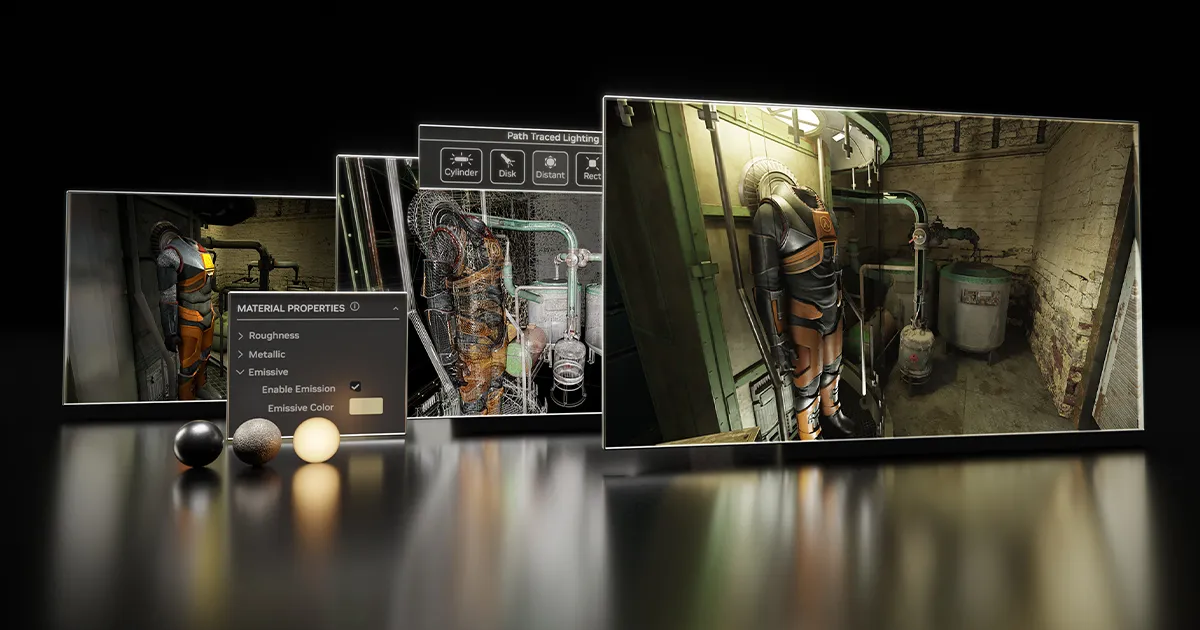
RTX Remix is still new but has significant potential. Thousands of classic PC games could see community‑driven visual remasters that rival modern titles. Early adoption is encouraging, with projects underway for Half‑Life 2, Deus Ex, and System Shock. NVIDIA open‑sourced the Remix runtime in 2023, further inviting community expansion.
This initiative merges old and new. Mods created with Remix also support DLSS 3 and Reflex, bringing modern performance features to games from decades past. RTX Remix shows NVIDIA’s commitment not just to pushing forward but to enriching the library of games players already love.
NVIDIA ACE: AI-Powered NPCs and Immersive Conversations
As graphics approach cinematic realism, another frontier is intelligence and interaction. NVIDIA’s Avatar Cloud Engine (ACE) for games is a suite of generative AI technologies aimed at making non‑player characters (NPCs) more lifelike. ACE enables NPCs to understand and respond to natural language, complete with AI‑driven voices and facial animations, setting the stage for unscripted, spoken conversations with game characters.
NVIDIA showed ACE at Computex 2023 in a tech demo called “Kairos.” The player approached the owner of a cyberpunk ramen shop and held a spoken conversation. Instead of picking dialogue options, the player pressed a key and asked a question via microphone. The NPC, Jin, responded with an answer that fit his backstory, generated on the fly rather than pulled from a dialogue tree. The conversation was simple but illustrated a future where AI drives dynamic storytelling.

ACE is not one AI but a toolkit of components. NVIDIA NeMo powers natural language understanding and text generation. NVIDIA Riva handles speech‑to‑text and text‑to‑speech, and Audio2Face animates the character’s face to match speech. These services can run locally or in the cloud and are offered as microservices for developers to integrate, giving them a plug‑and‑play way to add responsive NPCs without building everything from scratch.
The possibilities are significant. Future games might allow players to ask for hints, lore, or engage in free‑form conversation. NPCs could remember actions and reference them later. Studios are already exploring this: S.T.A.L.K.E.R. 2 and Fort Solis are using parts of ACE like Audio2Face, and more are likely to follow.
Challenges remain. Developers must ensure AI stays in character and avoids unwanted responses. The Kairos demo’s dialogue was basic, and running language models locally can compete with GPU resources needed for visuals. Still, ACE lowers the barrier for adding dynamic AI characters.
If DLSS and ray tracing made games look better, ACE could make them feel alive, marking another step in NVIDIA’s influence on the future of PC gaming.
Project G-Assist: An AI Companion for Gamers
While ACE focuses on AI inside games, NVIDIA’s Project G‑Assist brings AI to the gamer’s side as a personal assistant. Launched experimentally through the NVIDIA App in 2024, G‑Assist is an on‑device AI helper that lets you tune, control, and monitor your gaming PC with natural voice or text commands.
Instead of tabbing out or digging through settings, you can ask, “What’s my GPU temperature?” and get an instant answer, or “Show me a graph of my frame rate,” and see a live FPS chart while you play. You can switch display resolution, toggle G‑SYNC, or ask it to analyze stutter and suggest fixes, all through simple commands. G‑Assist ties into NVIDIA’s software stack, exposing features like driver settings and performance overlays through an intelligent, conversational interface.

NVIDIA describes it as “an AI assistant powered by your GeForce RTX PC that helps you tune, control, and optimize your system.” It runs small local AI models on the GPU, keeping data on‑device and working offline. When active, it uses a portion of the GPU’s Tensor Core capability to process commands. NVIDIA released plugin APIs so developers and hobbyists can extend G‑Assist, hinting at a broader ecosystem.
While not as flashy as ray tracing or DLSS, G‑Assist addresses a practical need: convenience and optimization. PC gamers often tweak drivers, monitor performance, or overclock, and doing so without interrupting gameplay is valuable. G‑Assist can chart key metrics in real time or adjust settings by voice, acting like a coach or technician alongside you. Because it is AI‑driven, its abilities can grow, potentially offering setting suggestions or integrating with online tools in the future.
Project G‑Assist shows NVIDIA’s push to make AI part of the overall gaming experience, not just graphics. It turns RTX hardware into more than raw performance by adding useful AI‑powered services for everyday play.
NVIDIA Broadcast: AI Enhancements for Streaming and Communication
Gaming today is rarely solitary. Many players stream gameplay or communicate over voice and video while playing. NVIDIA addressed this with NVIDIA Broadcast, an AI‑powered app that upgrades microphone, speaker, and webcam quality in real time. Launched in 2020 and built on the RTX Voice beta, Broadcast gives anyone with an RTX GPU professional‑grade audio and video effects without expensive gear.
With Broadcast, you can remove background noise from your microphone feed at the touch of a button. AI Noise Removal strips out keyboard clicks, PC fan hum, or even a barking dog, leaving only your voice. Room Echo Removal makes your voice sound as if you are in a studio instead of a reverberating room. On video, Broadcast offers a Virtual Background effect to blur or replace your room, no physical green screen needed. Auto Framing tracks your face and crops your webcam as you move, while newer effects like Eye Contact and Video Noise Removal further enhance appearance.
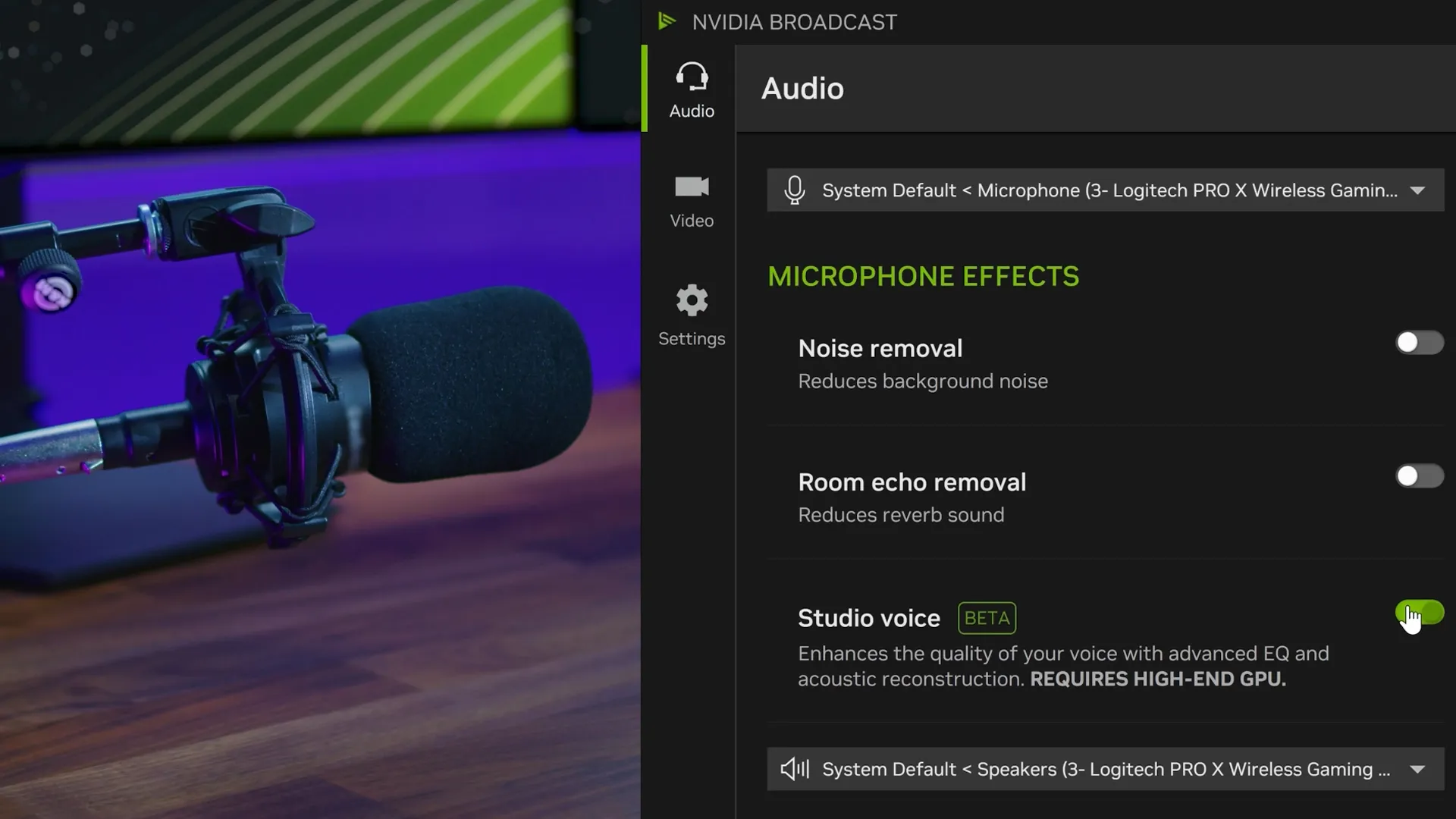
These features run in real time using GPU Tensor Cores for the AI processing. Streamers can sound clear and look polished without investing in high‑end microphones or cameras. Even regular gamers on voice chat or people working from home benefit, effectively turning any room into a broadcast studio.
Broadcast’s impact is visible across Twitch, YouTube, and Discord. Many creators rely on it to simplify setups, and apps like OBS Studio and Discord integrate NVIDIA’s noise suppression directly. Competing solutions often rely on CPU algorithms or costly pro gear, while Broadcast offers superior results free for RTX users.
NVIDIA Broadcast shows how NVIDIA broadens GPU value beyond graphics, making the PC experience better for streaming, chatting, and creating. As social gaming and content creation grow, tools like Broadcast further cement NVIDIA’s ecosystem advantage.
Why These Technologies Matter
We’ve discussed a suite of technologies, DLSS, Reflex, RTX Remix, ACE, G-Assist, Broadcast, each with its own specific benefits. It’s worth stepping back to see why NVIDIA has invested in these areas, and why they’re necessary for the evolution of gaming. In almost every case, it comes down to pushing against the limits of hardware and meeting rising user expectations through innovative solutions:
- Overcoming Hardware Limits: Traditional brute-force rendering is immensely demanding. As display resolutions increased (1080p to 1440p to 4K and now even 8K) and as gamers expect higher frame rates (120Hz, 144Hz, 240Hz displays), even the best GPUs can struggle to keep up, especially when advanced effects like ray tracing are enabled. DLSS was born from the realization that rendering every pixel with conventional techniques is inefficient, there’s a smarter way by leveraging AI and neural rendering. It addresses the fundamental hardware limitation of finite GPU throughput. Similarly, Frame Generation tackles the CPU bottleneck that can cap frame rates. Ray tracing itself was only made possible by specialized hardware and clever denoising. Without these, we’d be stuck with either poor performance or having to dial back visual fidelity. NVIDIA’s tech lets us have our cake (beautiful graphics) and eat it too (playable frame rates), something that was previously thought to be a distant goal. In essence, these technologies extend the effective performance of hardware beyond raw silicon capabilities; a necessity as manufacturing improvements slow down.
- Meeting (and Raising) User Expectations: Gamers today expect a lot: ultra-sharp graphics, no lag, instant response, rich content, and even the ability to share or modify their experiences. Features like Reflex directly respond to the expectation of low latency, which has heightened in the era of competitive esports. As display refresh rates and sensitivity to input lag increased, having 50-100ms of end-to-end latency (common in older setups) became unacceptable; Reflex helped bring that down into the tens of milliseconds or less, matching the expectation for near-instant reactions. RTX Remix, on the other hand, taps into the community’s expectation and hopes that classic games shouldn’t be left behind, gamers want to see their favorite titles looking good on modern displays, and even developers like to remaster hits of the past. Remix provides the means to do that in a way that satisfies modern graphical standards (e.g., seeing Half-Life 2 or Morrowind with path tracing and high-res textures satisfies a craving for nostalgia and quality). ACE addresses an expectation that has grown with the rise of open-world and role-playing games: players want deeper immersion and more dynamic worlds. Static NPCs repeating canned lines feel ever more outdated; ACE’s AI NPCs promise worlds where interactions are unscripted and personalized, which is the next level of player agency and immersion. Broadcast and G-Assist cater to the expectation that gaming PCs are multi-functional, they’re not just game consoles, they are studios, communication devices, and more. Users expect their system to handle streaming, chatting, and optimizing itself without hassle, and these AI tools do exactly that.
- Integration of AI into Modern Gaming: Broadly, we are witnessing a paradigm shift where AI is being woven into the fabric of games and gaming hardware. NVIDIA has been an early advocate of this trend. Why is AI needed? Because it opens doors that were firmly closed with conventional methods. AI can infer or predict solutions rather than explicitly compute everything from first principles, often at a fraction of the cost. For graphics, that means reconstructing a high-res image or an interim frame from prior data (DLSS) instead of brute-force rendering, essentially learning how to upscale or fill in motion. For game physics and animation, AI can learn patterns (e.g., neural physics for more realistic movements or AI for NPC behaviors) that would be incredibly complex to hand-code. For user interactions, AI (like in ACE or G-Assist) can parse natural language, something that traditional game code can’t do. The use of AI in modern gaming also stems from the plateauing of Moore’s Law; we can’t rely on pure hardware gains every year to solve our performance or feature wish lists. By offloading certain problems to learned models, we get a kind of software Moore’s Law, improvements in neural network research and training data can translate into better performance or quality on the same hardware over time (as we’ve seen with DLSS updates improving image quality within the same GPU generation). NVIDIA, having invested early in GPU computing and AI, was poised to apply those lessons to gaming. The result is that they have established early expertise in bringing AI features to gamers. This AI integration is increasingly not just an extra, but a requirement for tackling modern challenges, like rendering the metaverse, or simulating realistic worlds with countless interactive elements. NVIDIA often uses the term “neural rendering” to describe this fusion of AI and graphics, and it’s likely to be a cornerstone of gaming going forward.
In summary, NVIDIA’s technologies are necessary and impactful because they address the fundamental constraints and opportunities of our time: hardware limits, user demands for quality and immersion, and the burgeoning capability of AI to augment traditional methods. By introducing solutions like DLSS and Reflex, NVIDIA ensured that gamers can enjoy the fruits of advanced graphics now rather than waiting for hardware to slowly catch up. By pushing ray tracing, they set a new visual benchmark for the industry. By infusing AI into both content creation (Remix) and content consumption (Broadcast, G-Assist), they expanded what we expect our gaming PCs to do. All this cements the PC’s position as the leading edge of innovation in gaming, and NVIDIA as the company largely driving that edge.
Performance Gains and Ecosystem Adoption
No discussion of NVIDIA’s impact would be complete without quantifying some of the benefits their innovations have delivered, and how widely those innovations have been adopted by developers and gamers. Below, we compile a few key metrics and comparisons that highlight the improvements and the scale of NVIDIA’s technologies in the gaming ecosystem:
- Performance Improvements (DLSS & Frame Generation): The introduction of DLSS has delivered performance leaps without requiring new hardware. Compared to standard rendering on the same GPU, many games see 50 to 200 percent higher frame rates depending on DLSS mode. NVIDIA often advertises that DLSS can double frame rates in GPU‑limited scenarios. A real‑world case is Cyberpunk 2077’s “Path Tracing – Overdrive Mode.” At 4K without DLSS, even high‑end GPUs struggle to reach playable frame rates. With DLSS 3 in Quality mode plus Frame Generation, performance can jump from around 30 FPS to 80–100 FPS, turning an unplayable showcase into a smooth experience. Flight Simulator 2020 illustrates another advantage. DLSS 2 offered little improvement due to CPU limits, but DLSS 3’s Frame Generation bypassed that bottleneck for a 106 percent FPS gain over DLSS 2. These kinds of results extend GPU longevity, allowing gamers to enjoy new, demanding titles longer through NVIDIA’s software advancements.
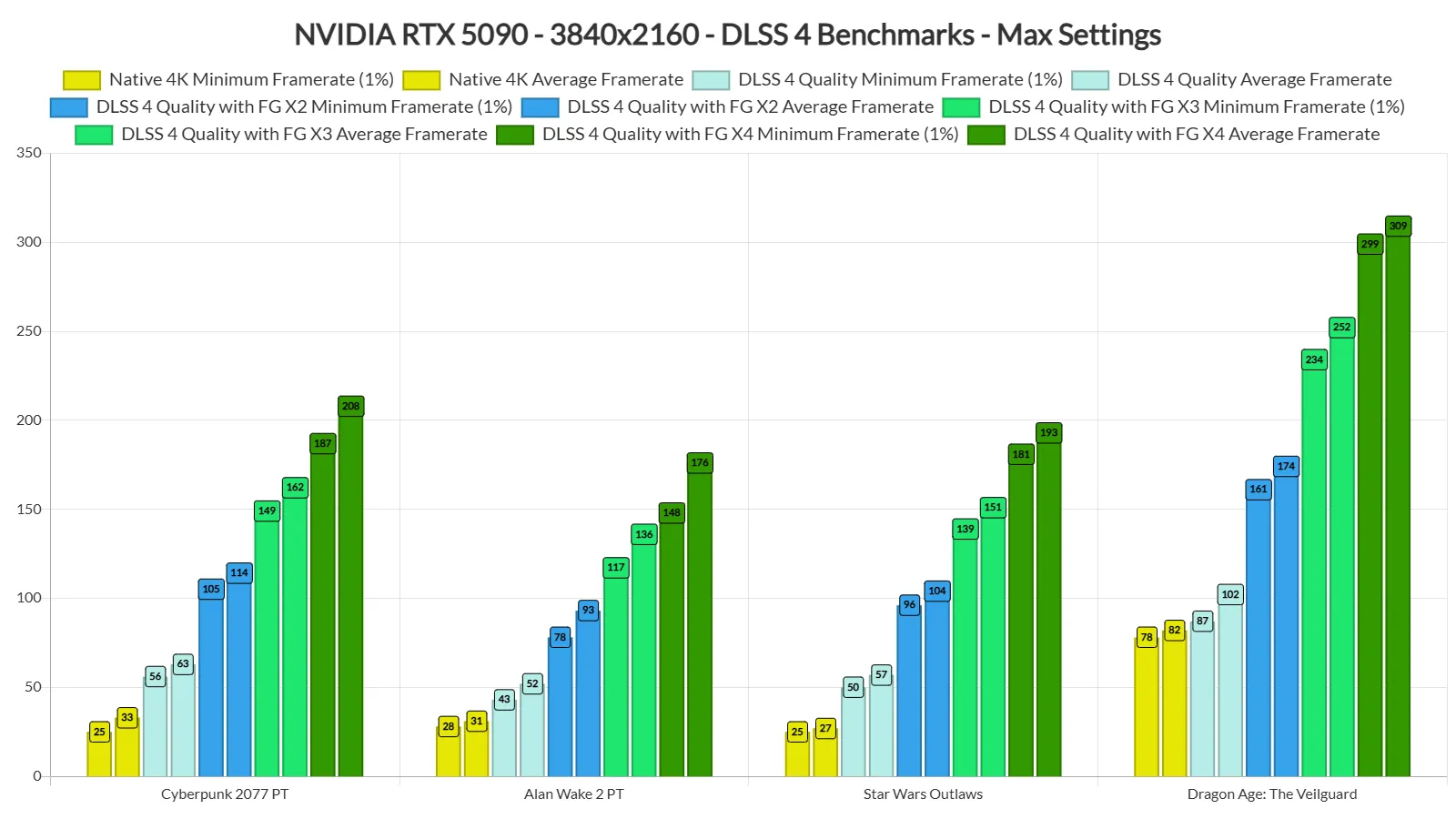
- Latency Reduction (Reflex & Higher FPS): NVIDIA Reflex reduces system latency by cutting down the GPU render queue that previously added 1–2 frames of delay. In Rainbow Six Siege, NVIDIA showed that at 60 FPS, Reflex lowered total system latency from about 63 ms to 53 ms (a 16 percent reduction). In Star Wars: Outlaws, enabling Reflex cut latency by up to 31 percent. Higher frame rates also help. When paired with DLSS (even without Frame Generation), the shorter frame intervals naturally reduce latency, and NVIDIA notes that DLSS with Reflex can offer latency comparable to or lower than native rendering at lower FPS. This proves you do not have to choose between performance and responsiveness. Reflex adoption is widespread. Over 90 percent of GeForce players enable it when available, and 9 of the top 10 shooters support it, directly targeting the genres where latency matters most. Reflex has effectively set a new standard, prompting competitive games to highlight latency reduction as a key feature.
- Adoption by Games and Developers: NVIDIA’s ecosystem approach has driven fairly wide adoption of its features. By mid‑2024, over 600 games and applications had implemented RTX technologies such as DLSS, Reflex, and ray tracing. By late 2024, that figure was over 800, covering major titles like Call of Duty, Battlefield, Fortnite, Minecraft RTX, Cyberpunk, and Assassin’s Creed, as well as engines like Unreal Engine, Unity, and Frostbite. Developers view these features as real value for players, and even studios focused on consoles integrate DLSS for their PC releases. NVIDIA’s own tools further expand reach. RTX Remix brings RTX tech into older classics, and Streamline provides an open API to make DLSS easier and future‑proof to implement. While competitors offer alternatives like AMD FSR, Intel XeSS, or Anti‑Lag, NVIDIA’s head start and proven results have kept DLSS and Reflex as the most preferred options where available.
- Community and User Adoption: Beyond official support, the enthusiast community has embraced NVIDIA’s tech. When a new game ships without DLSS, fans often mod DLSS 2 or 3 into the game if it uses Unreal Engine or another compatible engine. This happened with titles like Elden Ring and Starfield, showing how strongly PC gamers expect NVIDIA’s solutions. Many RTX owners actively seek out DLSS options and voice frustration when they are missing. On the streaming side, countless creators use NVIDIA Broadcast for noise removal or background effects, making it a common part of setup guides. What was once a novel concept, an AI‑powered broadcast studio, is now standard for RTX users. Even the phrase “RTX On” has entered gaming culture as shorthand for better graphics. These examples show NVIDIA’s features are not fringe experiments but mainstream tools that players and creators adopt eagerly.
- Unique Milestones and Firsts: NVIDIA’s history of “firsts” in PC gaming highlights major leaps in performance and capability. They delivered the first chip marketed as a GPU, the GeForce 256, which processed T&L on hardware and enabled dramatically more complex scenes. In 2006, the GeForce 8800 GTX introduced a unified shader architecture, boosting efficiency for modern shading languages. Fermi GPUs were first to support DirectX 11’s tessellation in hardware, adding detail to models on the fly. And in 2018, the GeForce RTX 2080 became the first consumer GPU with hardware ray tracing and AI cores, something previously considered impossible in real time. Each milestone brought tangible improvements in the games that followed. When NVIDIA pushes a new capability, developers tend to adopt it, and players see clear benefits. While others contribute, game studios innovate in gameplay and AMD has advanced open technologies, NVIDIA stands out for anticipating bottlenecks and delivering hardware‑software solutions that redefine what is possible in PC gaming.
In summary, the numbers and adoption rates back up the narrative: NVIDIA’s innovations aren’t just technically interesting, they deliver real improvements that developers and gamers have embraced on a large scale. A mid-range RTX GPU today, leveraging these features fully, can outshine a brute-force high-end GPU of a few years ago running without them. That has the potential to democratizes high-quality gaming and enables even flagship games to target advanced effects knowing that techniques like DLSS will make them runnable for more people. By the same token, NVIDIA’s features ensure that owning a GeForce isn’t just about raw specs, it’s about helping to provide a superior all-round ecosystem that yields better actual gameplay and usage outcomes.
The Influence of NVIDIA in PC Gaming
Considering all the areas we’ve explored, from hardware breakthroughs to AI-driven software, it becomes clear that NVIDIA holds a prominent place in the PC gaming industry. The company’s influence stems from a combination of technical excellence, forward-thinking strategy, and a holistic approach to solving gamers’ problems. A few key points underscore NVIDIA’s uniqueness and leadership:
- A Complete Platform (Hardware + Software): NVIDIA pairs powerful GPUs with a deep software stack that unlocks added value. Buying an NVIDIA GPU means buying into an ecosystem of features, DLSS, Reflex, RTX Remix, Broadcast, and more, that only work on that hardware. This tight integration is something competitors have struggled to match. Jensen Huang has said what matters is driving innovation and value, and NVIDIA has done that. While some call certain features proprietary, many of these ideas, adaptive sync, low‑latency modes, AI upscaling, later became industry trends. Gamers benefit directly, gaining cutting‑edge features sooner, while NVIDIA maintains a strong market lead.
- First-Mover and Risk Taker: NVIDIA has repeatedly taken bold bets that reshaped gaming. Programmable shaders in the GeForce3/4 series enabled more artistic freedom. PhysX brought GPU‑accelerated effects that led toward today’s physics‑based rendering. The biggest gamble was AI and ray tracing. RTX GPUs devoted die space to Tensor and RT cores before many believed real‑time ray tracing was feasible. Early RTX titles were few and demanding, but a few years later ray tracing is standard and DLSS has proved its value. NVIDIA’s willingness to “bet the farm,” as Huang put it, established a lead in these now‑essential features.
- Shaping Industry Direction: NVIDIA’s influence often sets de facto standards. Promoting HDR with GeForce 6/7 and early tessellation support pushed competitors to follow. DLSS’s success pressured the industry to create alternatives like FSR and XeSS, though none match its quality and performance. NVIDIA aids developers with contributions like RTX code for Unreal Engine and plugins for DLSS and Reflex, and often sends engineers to assist. Many major releases arrive “NVIDIA‑enhanced,” and cutting‑edge previews are frequently shown on NVIDIA hardware, accelerating the pace of game technology.
- Community Perception and Ecosystem Lock-in: NVIDIA has cultivated a brand that symbolizes performance and innovation. Even with closed approaches, many gamers trust NVIDIA to deliver features that work and improve their experience. Its ecosystem, G‑SYNC monitors, Reflex‑enabled devices, NVENC streaming support, creates strong incentives to stay within it. Over time NVIDIA has become synonymous with PC gaming hardware, a central driver of its high‑end landscape. Even if at times NVIDIA’s approaches are closed-source or tied to their hardware, a large section of the gaming community recognizes the practical benefits.
Yes, there are areas where NVIDIA has drawn significant criticism. The company’s approach to driver development remains a particular sore point, their reluctance to open-source drivers has created ongoing friction with the Linux community and limited functionality for users of alternative operating systems. The proprietary nature of technologies like DLSS and G-SYNC (before G-SYNC Compatible) has been criticized for creating vendor lock-in and fragmenting the PC gaming ecosystem. GameWorks, in particular, faced backlash from both developers and competitors for potentially creating “black box” optimizations that could harm performance on non-NVIDIA hardware. Some developers reported that GameWorks integration made it difficult to optimize for the broader market, potentially limiting their games’ accessibility.
Importantly, NVIDIA has achieved this while also contributing outside the proprietary sphere. They’ve open-sourced a lot of GameWorks libraries like PhysX, made many AI research projects public, and participate in standards bodies. So, while the company does fiercely protect its core IP (CUDA, DLSS algorithms, etc.), it’s not an entirely closed book. But ultimately even those who advocate for fully open solutions often concede that NVIDIA’s implementations often perform best. I believe NVIDIA has been overwhelmingly positive for the PC gaming ecosystem. They have pushed graphics forward when others might have been complacent, and they’ve done so in a way that gamers can directly enjoy (even if sometimes it means buying the latest GPU).
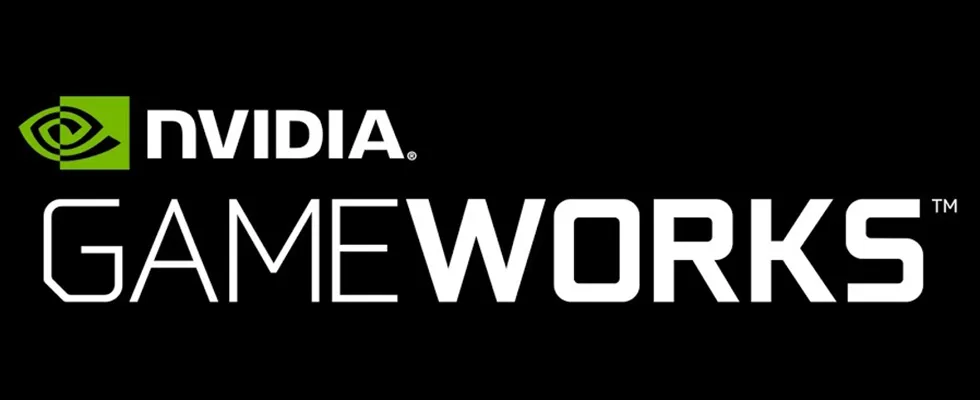
But looking at the big picture, those criticisms do not overshadow the tangible advancements NVIDIA delivered. As Huang remarked in an interview, what matters is creating “opportunities for everybody”, and he stressed that NVIDIA’s innovations have opened up new opportunities and driven the industry forward. This is evident in how gamers can play, what developers can create, and even how content creators can produce. NVIDIA’s work often expands what’s possible, and then everyone, players, devs, even competitors, adjust to that new normal.
Challenges and Limitations
While NVIDIA’s technologies have undeniably pushed gaming forward, they’re not without significant challenges. The increasing complexity of the software stack has created new potential points of failure, driver issues can now affect not just rendering but also AI features, latency optimization, and streaming capabilities. This complexity also raises the barrier to entry for troubleshooting; when issues arise, users must navigate an increasingly intricate web of interdependent technologies.
The proprietary nature of many NVIDIA innovations has created ecosystem fragmentation. Developers must often choose between leveraging NVIDIA-specific features that benefit a (large) portion of their audience or maintaining broader compatibility. This has led to situations where games ship with multiple rendering paths, increasing development complexity and potentially limiting optimization efforts.
Power consumption and heat generation have also become growing concerns. The push for ever-more-powerful GPUs has resulted in graphics cards that can consume 400-500 watts under load, requiring robust power supplies and cooling solutions that add to system cost and complexity. This trend toward higher power consumption runs counter to environmental concerns and can limit adoption in markets with high electricity costs or with users that just don’t want to upgrade other components.
Perhaps most significantly, the focus on AI-enhanced rendering raises philosophical questions about the future of graphics. As more of the final image is generated or enhanced by AI rather than traditionally rendered, where do we draw the line between “real” and “artificial” graphics? This shift represents a fundamental change in how we think about game visuals, from deterministic rendering to probabilistic generation, with implications we’re only beginning to understand.
A Look Back at NVIDIA’s Early Innovations in
PC Gaming
To understand how NVIDIA reached its current position at the center of PC gaming innovation, it helps to look back at the foundations it built. Revisiting those early breakthroughs shows how the company’s past decisions and risks set the stage for today’s AI‑driven features and explains why NVIDIA continues to shape the direction of gaming technology.
Inventing the GPU: A New Era of Graphics
In 1999, NVIDIA introduced the GeForce 256, marketing it as the world’s first “Graphics Processing Unit.” Instead of relying on the CPU for geometry calculations, it integrated hardware transform and lighting, allowing far more polygons without slowing gameplay. As Tom’s Hardware noted, it “took the strain off the CPU” and kept the 3D pipeline moving, letting developers add detail without bottlenecks. Firing up games like Quake III Arena on a GeForce GPU felt like seeing them anew. This breakthrough made dedicated GPU hardware essential and positioned NVIDIA as a leader in the shift to high‑performance graphics.
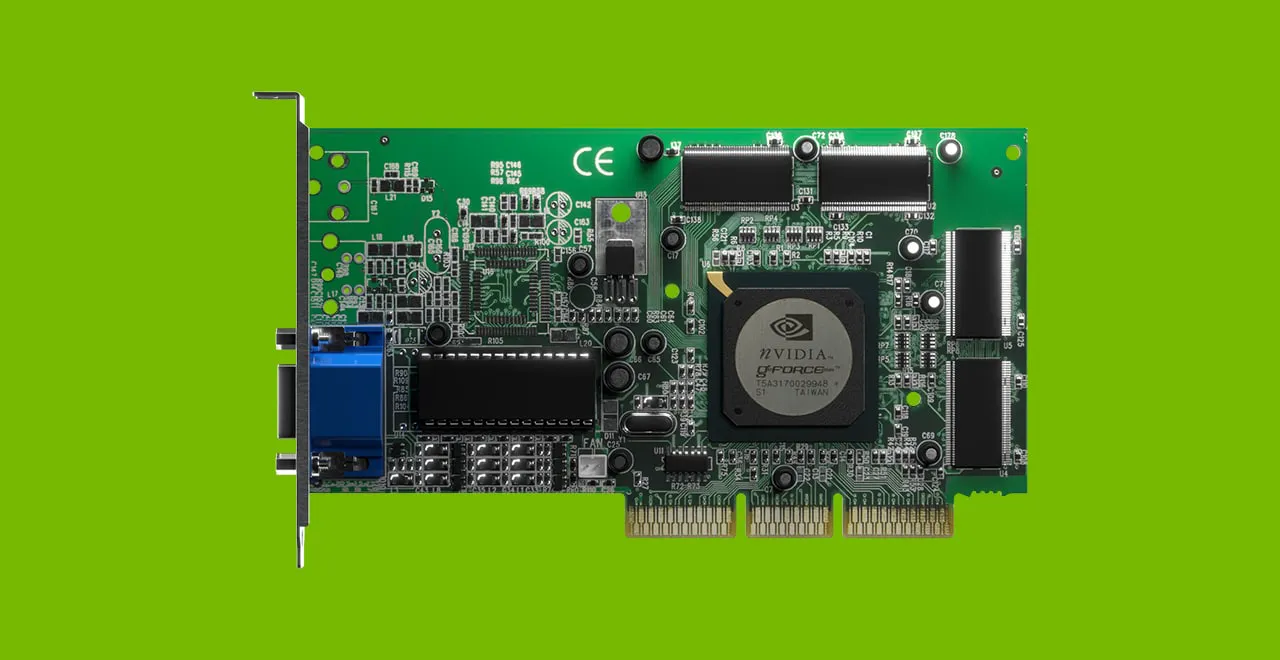
Over the next years, NVIDIA iterated quickly, adding programmable shaders and boosting performance each generation. Collaboration with developers led to richer textures, dynamic lighting, and smoother frame rates long before these were standard. The GPU evolved into a programmable platform not just for rendering but for computing, enabling features like live capture and encode that helped fuel streaming and esports. The invention and rapid advancement of the GPU set the stage for modern PC gaming.
Advancing Realism: From GameWorks to Real-Time Ray Tracing
As GPU power grew, NVIDIA pushed realism further with GameWorks, a suite of libraries providing ready‑made effects. PhysX added GPU‑accelerated physics, cloth that tears, debris that scatters, smoke and fluid effects, seen in games like Batman: Arkham City and Borderlands 2. Some questioned whether these effects changed gameplay or just added eye candy, but they clearly moved visuals forward. PhysX was later open‑sourced, indicating NVIDIA’s willingness to share tools that became widely used.
The pinnacle of realism is simulating light itself. For decades, real‑time ray tracing was considered impossible. In 2018, NVIDIA launched the RTX 20‑series with dedicated RT Cores for ray tracing and Tensor Cores for AI. Games like Battlefield V and Metro Exodus showed reflections and shadows following real physics, a milestone that influenced the entire industry. NVIDIA paired hardware with developer support, sample code, engine plugins, and manpower, helping more than 400 games implement RTX‑powered effects by 2024.
Early RTX titles did face trade‑offs. Performance often dropped when enabling ray tracing, and RT Cores reduced space for traditional raster performance, making some RTX 2000 cards perform worse in older workloads than GTX 1000 counterparts. Some players also felt the visual gains were subtle in everyday play. Yet the long‑term impact is clear: RTX set a new standard for lighting, merging AI and graphics to bring movie‑quality techniques into real‑time gaming.
Fostering a Developer Ecosystem: GameWorks, PhysX and Beyond
An often-overlooked part of NVIDIA’s impact on gaming is the developer ecosystem it has built. Beyond features like GameWorks and PhysX, NVIDIA’s Developer Relations team works closely with studios to optimize games for GeForce, provide early hardware and SDK access, and co‑develop custom features. The “The Way It’s Meant to Be Played” program signaled when games were optimized for NVIDIA hardware. While sometimes controversial for favoring proprietary features, the program helped many games achieve smooth performance and cutting‑edge visuals they might not have delivered otherwise. NVIDIA also times driver updates with big game launches, ensuring new titles run well on day one, making PC gaming more polished and reliable.
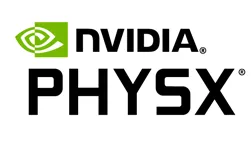
NVIDIA’s reach extends to engines and consoles. PhysX and other GameWorks tech were available on PlayStation and Xbox, allowing console‑focused titles to run even better on NVIDIA GPUs. More recently, platforms like Omniverse and the OptiX ray‑tracing engine have given developers advanced tools for both game creation and content production. Even initially proprietary ideas, such as low‑latency modes, often inspired broader industry standards. As CEO Jensen Huang said, “Whether it’s proprietary or open, the most important thing is whether it creates value for the ecosystem… NVIDIA has done that.”
Conclusion
In the span of a few decades, NVIDIA has fundamentally shaped the PC gaming world, arguably more than any other single company. From the introduction of the GPU that enabled a leap in 3D game complexity, to the latest AI-powered features that redefine performance and immersion, NVIDIA’s fingerprints are on nearly every major advancement in PC gaming technology. We’ve seen how DLSS and Frame Generation leverage AI to raise performance ceilings, allowing cards to punch above their weight and making intensive features like ray tracing viable for real-time games. We’ve examined how Reflex tackles latency head-on, catering to the core desire for responsiveness in gameplay and setting a new standard adopted by virtually all serious competitive titles. NVIDIA’s pursuit of realism through RTX (ray tracing) has brought genuine physical accuracy to game lighting, something that was a distant dream not long ago. Through tools like RTX Remix, the community is empowered to update the past, while technologies like ACE hint at a future where game worlds are populated with characters as reactive and unscripted as the player. Broadcast and G-Assist show NVIDIA’s keen understanding that gaming PCs are creative and social hubs, not just number-crunchers, these AI enhancements improve the quality of how we share games and how we manage our systems.
Crucially, all these innovations do not exist in isolation; they are part of NVIDIA’s broader strategy of integrating cutting-edge hardware with equally advanced software. The result is a cycle of innovation: better hardware enables new software techniques (like DLSS), and new software features drive the adoption of advanced hardware. Gamers benefit with richer, faster, and more immersive experiences. Developers benefit from tools and SDKs that let them push their vision without reinventing the wheel. The entire ecosystem moves forward, often times led by NVIDIA’s initial push.
NVIDIA’s role has not been without controversy, especially around open-source ideals and its penchant to build technology in a proprietary way, but even the skeptics largely acknowledge the practical value NVIDIA’s tech delivers. The company has charted its own path, often preferring to solve problems in-house and offer a polished solution rather than wait for industry-wide consensus. This has at times meant proprietary approaches, but as we’ve discussed, that focus on value and innovation has indeed benefited the gaming community. In many cases, NVIDIA’s proprietary solution set the stage for later open implementations or industry standards, and in the interim, gamers got to enjoy the future early. I believe that while open, cross-vendor standards are ideal in theory, the reality is that NVIDIA’s proactive innovation has driven the industry forward in ways that might never have happened (or happened far later) otherwise. The net effect is that PC gaming in 2025 is leaps and bounds ahead of where it was even five years ago, and a large credit for that goes to NVIDIA’s relentless R&D.
NVIDIA’s impact on PC gaming has been profoundly positive. By consistently delivering new technologies that enhance performance, visual fidelity, and user experience, NVIDIA has elevated what is expected from both gaming hardware and software. They’ve enabled game developers to create worlds of unprecedented realism and helped gamers enjoy those worlds in all their glory. Whether it’s through pioneering the first GPU or fusing AI into the very pixels on our screen, NVIDIA has been the tip of the spear driving gaming innovation. The breadth of these contributions has established NVIDIA as a key player in gaming’s evolution. As we look to the future, with trends like cloud gaming, virtual reality, and even deeper AI integration, NVIDIA’s track record suggests they will continue to be a key architect of that future. In the ever-evolving story of PC gaming, NVIDIA’s chapter stands out as one of bold innovation and ecosystem-wide advancement, cementing its status as arguably the most important and innovative company in the PC gaming space to date.